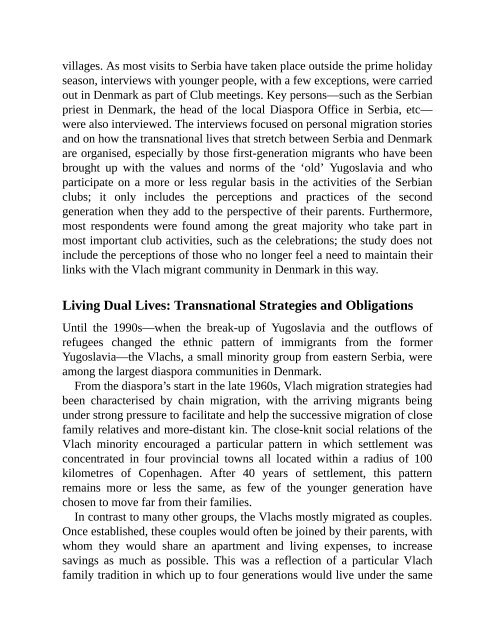Romanians from Serbia in Denmark
You also want an ePaper? Increase the reach of your titles
YUMPU automatically turns print PDFs into web optimized ePapers that Google loves.
villages. As most visits to <strong>Serbia</strong> have taken place outside the prime holiday<br />
season, <strong>in</strong>terviews with youngerpeople, with a few exceptions, were carried<br />
out <strong>in</strong> <strong>Denmark</strong> as part of Club meet<strong>in</strong>gs. Key persons—such as the<strong>Serbia</strong>n<br />
priest <strong>in</strong> <strong>Denmark</strong>, the head of the local Diaspora Office <strong>in</strong> <strong>Serbia</strong>, etc—<br />
were also <strong>in</strong>terviewed. The <strong>in</strong>terviews focused on personal migration stories<br />
and on how the transnationallives that stretch between <strong>Serbia</strong> and <strong>Denmark</strong><br />
are organised, especially by those first-generation migrants whohave been<br />
brought up with the values and norms of the ‘old’ Yugoslavia and who<br />
participate on a more or less regular basis <strong>in</strong> the activities of the <strong>Serbia</strong>n<br />
clubs; it only <strong>in</strong>cludes the perceptions and practices of the second<br />
generation when they add to the perspective of their parents. Furthermore,<br />
most respondents were found among the great majority who take part <strong>in</strong><br />
most important club activities, such as the celebrations; the studydoes not<br />
<strong>in</strong>clude the perceptions of those who no longer feel a need to ma<strong>in</strong>ta<strong>in</strong> their<br />
l<strong>in</strong>ks with the Vlachmigrant community <strong>in</strong> <strong>Denmark</strong> <strong>in</strong> this way.<br />
Liv<strong>in</strong>g Dual Lives: Transnational Strategies and Obligations<br />
Until the 1990s—when the break-up of Yugoslavia and the outflows of<br />
refugees changed the ethnic pattern of immigrants <strong>from</strong> the former<br />
Yugoslavia—the Vlachs, a small m<strong>in</strong>ority group <strong>from</strong> eastern <strong>Serbia</strong>, were<br />
among thelargest diaspora communities <strong>in</strong> <strong>Denmark</strong>.<br />
From the diaspora’s start <strong>in</strong> the late 1960s, Vlach migration strategies had<br />
been characterised by cha<strong>in</strong> migration, with the arriv<strong>in</strong>g migrants be<strong>in</strong>g<br />
under strong pressure to facilitate and help the successive migrationof close<br />
family relatives and more-distant k<strong>in</strong>. The close-knit social relations of the<br />
Vlach m<strong>in</strong>ority encouraged a particular pattern <strong>in</strong> which settlement was<br />
concentrated <strong>in</strong> four prov<strong>in</strong>cial towns all located with<strong>in</strong> a radius of 100<br />
kilometres of Copenhagen. After 40 years of settlement, this pattern<br />
rema<strong>in</strong>s more or less the same, as few of the younger generation have<br />
chosen to move far <strong>from</strong> their families.<br />
In contrast to many other groups, the Vlachs mostly migrated as couples.<br />
Once established, these couples wouldoften be jo<strong>in</strong>ed by their parents, with<br />
whom they would share an apartment and liv<strong>in</strong>g expenses, to <strong>in</strong>crease<br />
sav<strong>in</strong>gs as much as possible. This was a reflection of a particular Vlach<br />
family tradition <strong>in</strong> which up to fourgenerations would live under the same
















